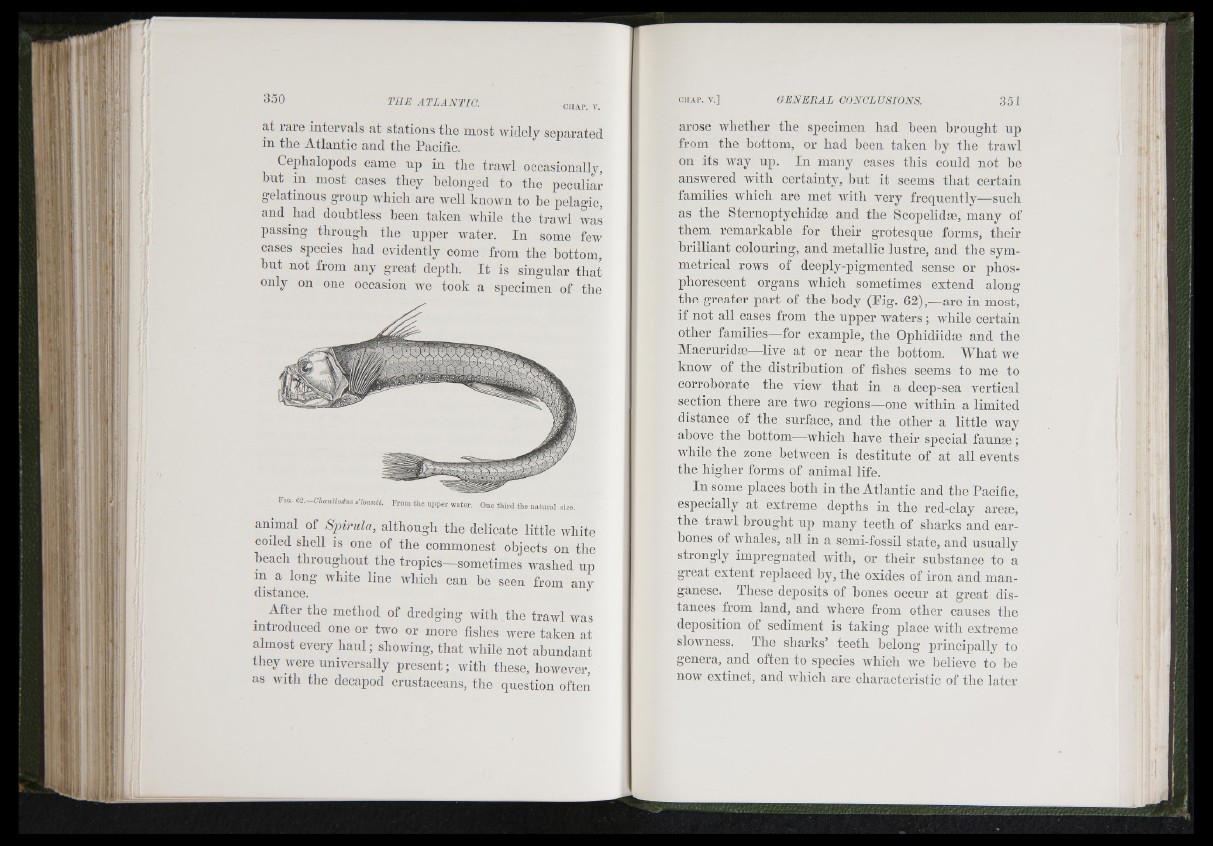
at rare intervals at stations tlie most widely separated
in the Atlantic and the Pacific.
Cepholopods came up in the traivl occasionally,
hut ill most cases they belonged to the peculiar
gelatinous group Avhich are Avell known to be pelagic,
and had doubtless been taken Avbile tbe trawl was
passing tbroiigb tbe upper Avater. In some few
cases species bad evidently come from tbe bottom,
but not from any great deptb. I t is singular tbat
only on one occasion aa'c took a specimen of tbe
Fig. e z -C h a u lio d u s flo a n ii. From the u p p e r w.-,ter. One th ird the n a tu ra l size,
animal of Spirula, altbougb tbe delicate little wbite
coiled sbell is one of tbe commonest objects on tbe
beacb tbrougbout tbe tropics—sometimes washed up
m a long wbite line Avbich can be seen from any
distance.
After the metbod of dredging with tbe trawl was
introduced one or two or more fishes were taken at
almost every h a u l; showing, th at while not abundant
they were universally present; Avith these, however,
as with the decapod crustaceans, tbe question often
arose whether the specimen had been brought up
from the bottom, or had heen taken hy the traAvl
on its Avay up. In many cases tbis could not be
answered with certainty, but it seems tb a t certain
families Avbicb are met Avitb very frequently—such
as the Sternoptychidae and the Scopelidæ, many of
them remarkahle for their grotesque forms, their
brilliant colouring, and metallic lustre, and the symmetrical
roAvs of deeply-pigmented sense or phosphorescent
organs which sometimes extend along
the greater p a rt of the body (Pig. 62),—are in most,
if not all cases from the upper waters ; Avbile certain
other families—for example, tbe Ophidiidæ and the
Macruridæ—live at or near the bottom. What we
know of the distribution of fishes seems to me to
corroborate the vieAV th a t in a deep-sea vertical
section there are tAvo regions—one within a limited
distance of the surface, and the other a little way
ahove the bottom—Avhich have their special faunæ ;
Avhile the zone between is destitute of at all events
the higher forms of animal life.
In some places hoth in the Atlantic and tbe Pacific,
especially at extreme depths in tbe red-clay areæ,
the traAvl brought up many teeth of sharks and carbones
ot Avhales, all in a semi-fossil state, and usually
strongly impregnated AA'ith, or their substance to a
great extent replaced by, tbe oxides of iron and manganese.
Tbese deposits of bones occur at great distances
from land, and where from other causes the
deposition of sediment is taking place Avith extreme
slowness. The sharks’ teeth belong principally to
genera, and often to species Avhich AA'e belicA'e to he
now extinct, and AAdiich are characteristic of the later
' t